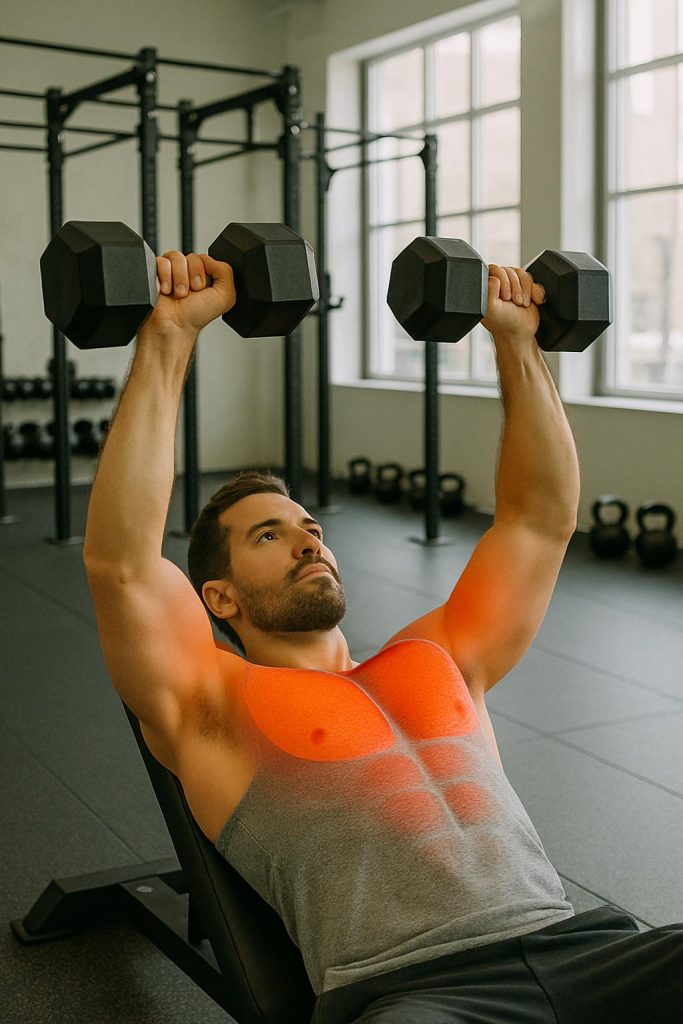The bench press mainly works your chest, shoulders, and triceps, making it one of the most effective exercises for building upper-body strength. If you want to increase muscle mass, improve athletic performance, or simply get stronger, understanding the bench press is crucial.
This guide covers exactly which muscles the bench press targets, its key benefits, how to do it safely, common variations, and the latest research—all based on the most current expert data. You’ll also get actionable programming tips and visuals for every section. For official safety information, always check resources like the NSCA Bench Press Guide.

Muscles Worked by the Bench Press
Primary Muscles Targeted
- Pectoralis Major (Chest): The main driver in every bench press rep.
- Anterior Deltoids (Front Shoulders): Help push the weight upward.
- Triceps Brachii (Back of Arm): Responsible for elbow extension and lockout.
Key Supporting Muscles
- Serratus Anterior & Rotator Cuff: Stabilize the shoulder joint.
- Latissimus Dorsi: Provides upper back tightness.
- Core (Abdominals & Lower Back): Braces and protects the spine.
Research insight:
A 2024 Sport Science Insider review and EMG studies confirm that grip width and bench angle shift muscle emphasis. For example, a close grip increases triceps involvement, while an incline bench boosts upper chest activation.
Top Benefits of Bench Press
- Muscle Growth & Strength: The bench press is the gold standard for developing a powerful chest, strong arms, and shoulders. Multiple studies rank it as the best single lift for upper-body strength (Garage Gym Reviews, 2024).
- Improved Bone Health: Like other compound lifts, bench pressing helps build bone density, reducing your risk of osteoporosis over time (GoodRx Health, 2024).
- Athletic & Functional Performance: Bench pressing transfers to better performance in sports, push-ups, and everyday tasks like lifting or pushing objects.
- Boosted Metabolism & Heart Health: Regular resistance training with moves like bench press helps increase resting metabolism and supports cardiovascular wellness (Healthline, 2024).
- Versatility & Customization: With simple variations, you can shift the focus to different muscle groups or adapt for joint health and comfort.
How to Bench Press: Step-by-Step Guide
- Set Up: Lie flat with eyes under the bar. Plant feet firmly on the ground. Grip the bar just wider than shoulder-width.
- Unrack and Lower: Unrack the bar with arms extended. Lower it slowly to your mid-chest, elbows at ~45 degrees.
- Press and Lockout: Drive the bar back up, pushing through your feet and tightening your core. Finish with arms straight but elbows soft.
- Rack Safely: Guide the bar back to the rack carefully after each set.
Safety Tips:
- Always use a spotter or set the safety bars.
- Warm up thoroughly before heavy lifts.
- Avoid excessive arching or bouncing the bar.
- Rest at least 48 hours between chest sessions for optimal recovery.
For more technique info, see the ACE Fitness Bench Press Guide.
Bench Press Variations: Targeted Muscle Focus
- Flat Barbell Bench Press: Balanced activation for chest, front shoulders, and triceps.
- Incline Bench Press: Bench angled at 30–45° emphasizes the upper chest and anterior deltoids (Outlift, 2024).
- Decline Bench Press: Emphasizes the lower chest while reducing shoulder strain.
- Close-Grip Bench Press: Targets the triceps more than the standard grip, ideal for arm development.
- Dumbbell Bench Press: Promotes equal strength between sides and a greater range of motion.
- Reverse-Grip & Spoto Press: Reverse grip focuses on the upper chest; Spoto press builds power and stability at the bottom.
How Grip & Range Affect Muscle Activation
- Wide Grip: More chest, less triceps.
- Close Grip: More triceps, slightly less chest.
- Partial Range: Can maximize muscle activation and protect joints, per a recent Nature study, 2024.
Bench Press Sets, Reps & Programming
| Goal | Sets × Reps | Intensity (%1RM) | Rest Between Sets |
|---|---|---|---|
| Strength | 4–6 × 3–6 | 85%+ | 2–5 min |
| Hypertrophy | 3–6 × 6–12 | 67–85% | 30–90 sec |
| Endurance | 3–4 × 12+ | <67% | <30 sec |
Source: GoodRx Health, 2024
Programming tip: For the best results, increase your weight, reps, or sets gradually over time. Beginners should focus on perfect form before increasing load.
Frequently Asked Questions
- Is the bench press safe for beginners? Yes, with proper form and a spotter or safety arms. Start with just the bar to learn the movement.
- How often should I bench press? 2–3 times per week, with at least 48 hours between sessions targeting the same muscles.
- What is a good starting weight? Begin with the empty bar (usually 45 lbs/20 kg), adding weight slowly as you get stronger.
- Can bench press replace push-ups? Both have value. Bench press is better for pure strength and muscle growth; push-ups are great for endurance and convenience.
For more, see the NSCA FAQ.
Conclusion
The bench press is a cornerstone of strength training, building your chest, shoulders, and triceps while boosting your performance in sports and daily life. Master the basics, choose the right variation, and progress wisely to maximize your results.
Video Resource
A highly-rated YouTube guide for safe and effective bench press technique:
